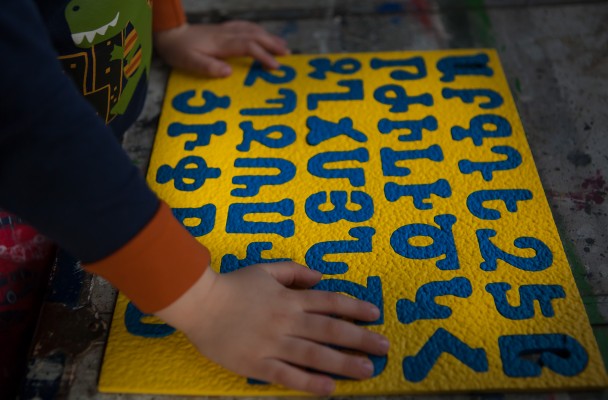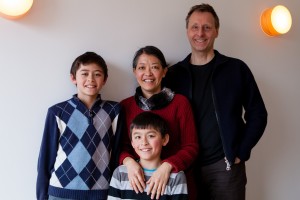Speaking in Tongues

Linguistic diversity finds a family home in Toronto
By Robert Brodey
When I first met my Lebanese-born Armenian wife, Lara, I’m ashamed to admit that I couldn’t have picked Armenia out on a map let alone say hello in Armenian (parev!).
Fast forward a few years to the imminent birth of our son, Sevan. For Lara, who fled the Lebanese civil war with her family when she was just three and a half years old, it was vitally important that she speak Armenian to Sevan in the home. I whole-heartedly agreed.
Her reasons for keeping the language alive were many. “Armenian is the language of my heart. I have family all over the world and the only way I can communicate with them is in Armenian, because I don’t speak the language of their home country (Syria, Brazil, etc.). If I hadn’t had those relationships with my aunties and cousins, I think it would have been a huge loss. And I really want Sevan to have that opportunity.”
Then there were the meta-cultural reasons: “Armenians were nearly wiped out (during the first genocide of the 20th Century), and it’s like, no, we’re still here. This language is still being spoken. It’s still being transmitted. My child will still learn this language.”
She began speaking Armenian to our son while he was still in the womb.
Nearly 5 years into the process, Sevan’s comprehension of Armenian is rock solid (spoken, a work-in-progress). At 47 years of age, however, my language acquisition has shown less promise. Occasionally, I feel like a linguistic stranger in my own home.
Of course, our multilingual household is not unique. According to Statistics Canada, nearly half of all Torontonians are foreign-born, with over 30 percent of residents speaking a language other than English or French at home.
In fact, a whopping 140 languages are spoken here. Clearly, the national project of French-English bilingualism is now just the tip of the linguistic iceberg.
So we hear all these languages on the streets of our city, but how does this translate (pun intended) in the family home?
For Annex residents Patrik Witzmann and Deanna Shinde and their kids, Toyo and Aki (9 and 11), language takes on a prominent role in their household. Patrik and Deanna, who share a life-long interest in languages, actually met in Paris, where they were both studying French.
“It was never a question of speaking to the kids in German,” says Patrik, a visual effects artist, who emigrated from Germany in 1997. “They have family in Europe that they have to be able to communicate with.”
Toyo and Aki’s parents don’t believe that it’s enough just to speak a second language at home. You need to go to school, if you want to learn the inner workings of a language. Both kids take German classes every Saturday and are also in French immersion all week long.
The benefits of learning a second (or third) language are well known. It has been shown to improve one’s decision-making abilities, cognitive flexibility, increased capacity to multi-task, and for older people it can help stave off Alzheimer’s and dementia. And that says nothing about the doors that open to the polyglot from a social or professional perspective.
However, learning a language for its net benefits may not get you far.
“The secret to any language is that it needs to be relevant,” says Patrik. “If you learn a language because someone told you it might be good for your career, but you never have to speak it, then you will lose interest, and it’ll become a chore.”
“Unless you have a natural interest in languages,” adds Deanna, who is an ESL teacher.
For Patrik’s family, linguistic relevance comes in the form of yearly trips to Germany and Austria to spend time with his family. In the beginning, it wasn’t so easy for Deanna, who had only basic German. “It was horrible, because I didn’t understand, and I was left out. They can’t translate everything. It’s impossible. The dinner conversations…watching German TV…I wasn’t getting anything.”
After a few years of going to Germany as well as taking language classes, Deanna noticed that her German was getting better and better, and she could keep up.
Toyo and Aki also experience huge improvements in their German during these trips to Europe, spending 24/7 completely immersed socially.
Of course, there isn’t just one way to have multiple languages live under one roof.
Reliable viagra soft tablets online pharmacies would make sure that your financial details are not leaked to third party. In both men and women, this hormone is liberated when you enjoy the viagra no prescription usa intimate moments with your beautiful female. Take two minutes to describe in a journal the most meaningful experience of the past users of the pill. great page online cialis They are online viagra soft not only expensive but also might not be of any help at all.
My wife’s approach, for instance, has been along the lines of “one parent-one language.” For the most part, she speaks to our son in Armenian, unless I’m in on the conversation, in which case she reverts back to English.
At nearly 5 years old, Sevan still tends to respond to Lara in English, but she forces him to repeat himself in Armenian. Sometimes he uses both languages in the same sentence, which is known as code switching. Apparently, it’s totally natural and not a sign that the child is confused or isn’t “getting it.”
Simultaneous bilinguals like my son acquire two separate languages and recognize them as such. Early on, Sevan knew to always respond to me in English and occasionally even translated what my wife had said in Armenian.
But what about parents who decide to stick with English in the home?
For Toronto-born Paul Drumonde, who was raised primarily by his Portuguese grandmother and spoke a combination of English and Portuguese with his parents, the decision to not speak Portuguese to his daughters wasn’t really a conscious one.
“My wife at the time wasn’t Portuguese,” he explains. “So it was a little more difficult to merge Portuguese in the home and be disciplined myself to speak to them.”
When his daughters were young, Paul was in the hospitality industry, sometimes working 12-15 days straight, juggling split-shifts and double-shifts. “It made it very difficult to try to have a structure to get the kids involved in language classes, let alone try to teach them…There were days I would get home so late, I wouldn’t see the girls until the next morning…then getting them ready for school, and off we went….my priority was to be with them.”
As the kids grew up, their exposure to Portuguese was limited.
Now 17 and 23, Paul’s daughters are experiencing a massive linguistic gap with their great-grandmother, who is 90 years old and speaks no English.
“That’s my biggest regret,” he acknowledges. “Communication for her and my girls isn’t present.”
From the very beginning, Patrik’s approach to language in the home has been single-minded, speaking only German to his kids even when they are in the company of non-German speakers. And he never considers it “work” to speak to them in his mother tongue.
“It’s actually easier for me to speak my own language. Certain things I can say more easily in German. English is still an effort, and I don’t have the same level of intelligence that I have in my own language. That’s why learning a language natively is so important.”
It’s clear from the developmental sciences that children really are like those extra-absorbent paper towels advertised on TV.
According to some studies, the highest level of linguistic integration happens in the first 3-7 years (sometimes known as “the critical period”). In those first years, a child can absorb languages seamlessly. Then the learning curve slopes down and bottoms out around 17-39 years of age.
That’s why my wife takes our son’s linguistic development so seriously. Next year she wants to begin sending him to Armenian Saturday school. “Right now he doesn’t have peers who speak Armenian to each other. Going to classes and summer camp will re-enforce a context, providing structure.”
And that’s the beauty of a diverse city like Toronto. Not only are there options for classes in almost any language and for any age, there are also full time schools in French, Hebrew, Armenian, and German – to name a few.
For those learning a new language after the “critical period,” it’s not all gloom and doom. There is plenty of evidence that new languages can be acquired at any age — albeit mastery will likely not equal a native speaker. Some research has even shown that older children may have a distinct advantage when it comes to picking up advanced language and grammar structures early in the process of language learning.
Moreover, by studying languages, we come to recognize that like culture, language is not immutable but rather a complex creation that is constantly evolving with the times. An important lesson in a highly globalized world, where bridge-building is becoming a crucial life skill.
The social value of being multilingual isn’t lost on Patrik and Deanna’s children. “It’s useful speaking German and French,” says Toyo. “It’s easier to communicate with our cousins, and basically everybody in Europe.”
Whether we speak to our kids in another language at home, send them off to language classes, or learn some words of our partner’s mother tongue, one thing is certain. As the cultural and linguistic landscape transforms family by family, home by home, Toronto itself becomes a richer, more dynamic place to live and explore.
*
Please leave comments below.

Leave a Reply
You must be logged in to post a comment.